Absolute chronology
To establish numerical age estimates of an archaeological or paleontological site, specialists use dating techniques that can provide absolute dates. There are many methods to define absolute dates, including the two methods applied by our project: radiocarbon dating (C-14 dating) and archaeomagnetic studies.
For each of these techniques, it is necessary to sample specific material types that are datable from the excavation area. For instance, organic remains from ecofacts made of wood, charcoal, bone, and shell are crucial for conducting C-14 dating. Archaeomagnetic dating, on the other hand, requires very different materials such as construction material, stucco, and ovens. These samples are sent to specialists trained in utilizing specialized equipment and lab facilities depending on the applied dating method.
Radiocarbon
Radiocarbon dating examines the unstable and radioactive isotope of carbon-14 (14C). This dating technique has been an essential technique since the mid-twentieth century for estimating the age of many paleontological and archaeological sites around the world.
All living organisms absorb carbon-14, and when these organisms die, 14C begins to decay at a constant rate. As a result, it is possible to calculate how much time has elapsed from the time an organism died through the ratio of stable and unstable 14C remaining in archaeological or fossil organic remains such as wood, coal, bone, shell, and collagen. These dates are then used to infer the ages of archaeological or paleontological sites.
This project has already submitted multiple charcoal and bone samples to the Accelerator Mass Spectrometry Laboratory (AMS) of the University of Arizona and to Beta Analytic.
Archaeomagnetic studies
Archaeomagnetic dating is another specialized technique used by archaeologists to calculate an absolute age of a site. This method detects subtle shifts in Earth’s magnetic field. This includes changes in the direction of magnetic north and its intensity which have changed over time, and afterwards it compares the magnetic alignment of archaeological materials to these known shifts.
Samples from the first season of the project are already underway for archaeomagnetic dating. Dr. Soler is taking the lead with the analysis, and she is conducting her work at the Laboratory of Paleomagnetism (Division of Archaeomagnetic Studies) at the Institute of Geophysics, National Autonomous University of Mexico (UNAM). We hope the results of this study will help give us an absolute date to this region and furthermore define when the sampled structures were utilized.
But what is it?
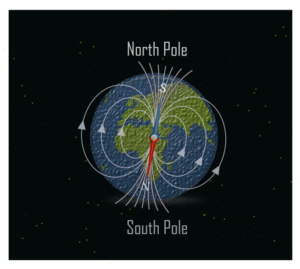 To understand how this technique works, we need to first talk about our planet and its magnetic properties. The planet Earth behaves like a giant magnet with magnetic forces radiating from it. The magnetic South Pole aligns by geographic North Pole while magnetic North corresponds to geographic South Pole. The exact location of the magnetic poles is not constant and gradually shifts over time. These changes in direction and intensity of the magnetic field have been recognized and studied since the mid-seventeenth century. Today, these observations are used to create a map that plots a secular variation curve, which is a graphic representation of a table recording the location of the magnetic north across time.
To understand how this technique works, we need to first talk about our planet and its magnetic properties. The planet Earth behaves like a giant magnet with magnetic forces radiating from it. The magnetic South Pole aligns by geographic North Pole while magnetic North corresponds to geographic South Pole. The exact location of the magnetic poles is not constant and gradually shifts over time. These changes in direction and intensity of the magnetic field have been recognized and studied since the mid-seventeenth century. Today, these observations are used to create a map that plots a secular variation curve, which is a graphic representation of a table recording the location of the magnetic north across time.
Furthermore, iron oxide minerals (hematite, magnetite, etc.) also have magnetic properties that are lost when reaching high temperatures (500-700 °C) in case of fire, for example. As the minerals cool down, they realign to reflect the direction of the Earth’s magnetic field at that moment. The magnetization acquired by these minerals is called thermoremanent magnetism, and the minerals retain this charge over time.
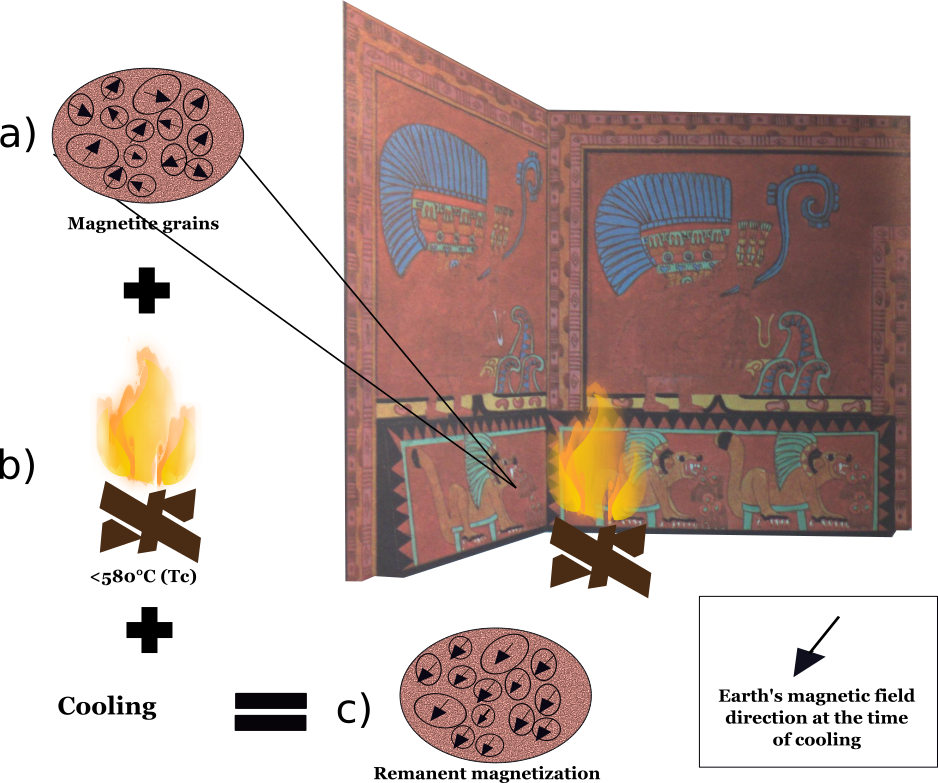
Since antiquity, magnetic minerals were used to color floors, walls, murals, and ceramics. This, in turn, has led them to be exposed to high temperatures that have rendered them useful for dating. These minerals are then used to estimate the age of archaeological sites by comparing magnetization characteristics with a secular variation curve.
What kinds of materials are used for archaeomagnetic studies?
Archaeological features that retain the alignment of Earth’s magnetic field include ovens, burned floors or walls, comales, and stoves (fogones). Researchers have also recently discovered that murals or stucco walls containing certain minerals in the paint (e.g., ground hematite) can also document the magnetic field alignment at the time of creation (Dr. Ana Ma. Soler Arechalde, personal communication).
Archaeomagnetic samples need to be taken from excavations with strict stratigraphic control, as this contextual information is essential for refining the estimation of any reference dates. Additionally, it is advisable to use other absolute dating techniques such as radiocarbon dating, thermoluminescence, or obsidian hydration to cross-reference the results from archaeomagnetic analysis.
Sampling for archaeomagnetic studies
During the project’s first season of excavation, Dr. Ana Soler took several samples to estimate the absolute age of the site.
The general protocol for retrieving an archaeomagnetic sample is outlined below. These procedures are for taking archaeomagnetic floor samples, and there are slight variations in sampling strategies depending on the context.
- Samples are taken by using a wooden cylinder of 2.54 cm in diameter and 2.1 cm high. About ten of these cylinder pieces are adhered to the surface with non-magnetic epoxy glue. Each piece is then named and marked, ready to be oriented.
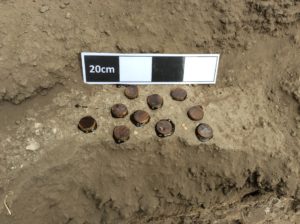
- The samples are oriented using a Brunton compass, and an arrow is drawn with permanent ink indicating its position in relation to geographic north (degrees). Its inclination relative to the horizontal plane (degrees) is calculated by using the compass’ clinometer. This orientation and inclination are used to establish the directional field value of each specimen in geographical coordinates.
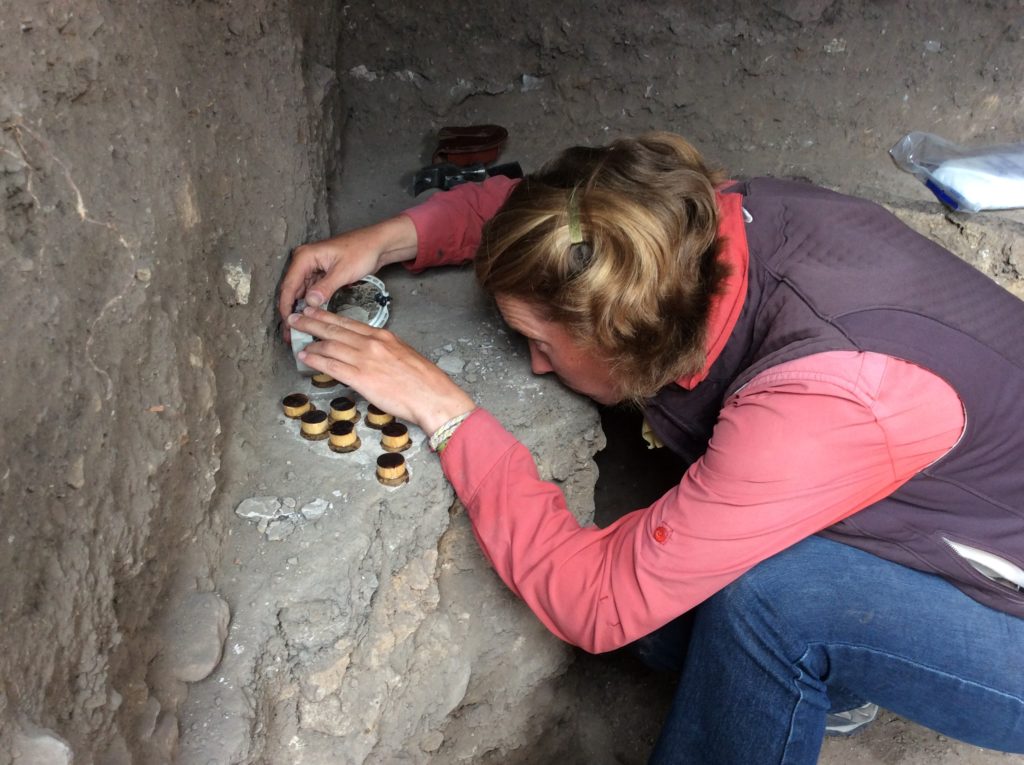
Sample orientation, 2015
- The wooden cylinders are then carefully removed with chisels, hammers and spatula, making sure the stucco layer of the floor or wall is well adhered to the wood.
- The wooden chips with stucco are subsequently wrapped in cotton and labeled with its sample number.
- The number of wooden chips taken for each sample varies depending on site conditions, but there are usually between 10 and 12 specimens taken for each sample.
- The samples are further processed in the laboratory to the appropriate dimensions for analysis in the magnetometers.
- This magnetometer generates increasing levels of alternating fields to determine the field direction for each specimen.
- Fisher statistics are applied to the results for all the specimens to define an average direction of the sample. This direction is the one that is finally compared to secular variation curves using Bayesian statistics (declination (or angle relative to magnetic north) and inclination (or angle to the horizontal plane)) to get statistically probable age determinations. Because this calculation is based on statistics, the larger the sample size, the stronger the confidence interval.
Samples can also be taken as a bulk sample in the form of a block. The procedure is like that described above, but the block is oriented only once. In this instance, the samples are larger to accommodate division of the sample in the laboratory later in more controlled situations.
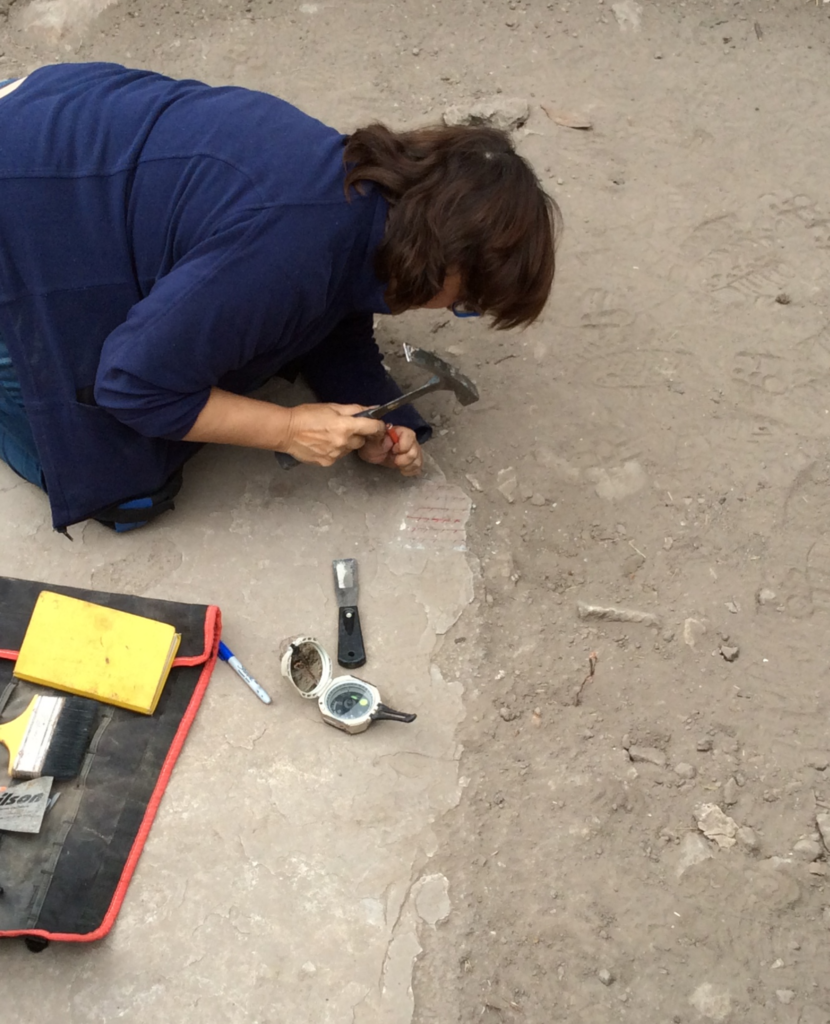
Don’t forget to visit this page later to check the results of these analyses!
References
Séjourné, L. 1969. Teotihuacan Métropole de l’Amérique. François Maspero, Paris, pp. 318.
Soler Arechalde, A. M. 2014. Arqueomagnetismo en Mexico 1965-2013. Latinmag Letter 4(4): 1-14.